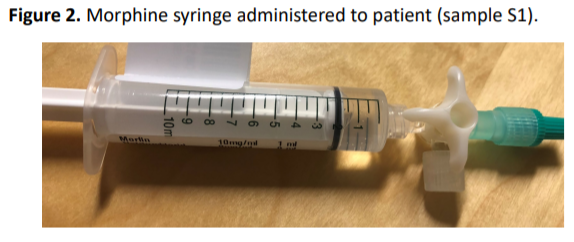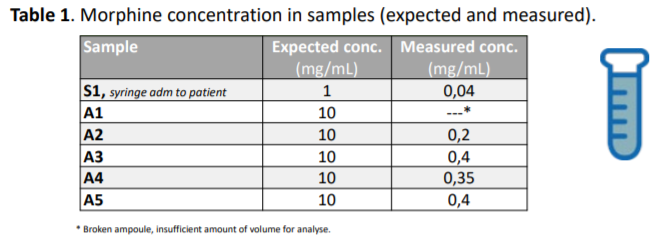Baghdarsarian, R1, Hellström, K1, Paulsson, M2*
1 Uppsala University Hospital Compounding Unit, CU
2 Department of Children’s and Women’s Health, Uppsala University, Entr 95/96, SE75185 Uppsala, Sweden. *Corresponding and presenting author.
1. What was done?
In a case with suspected tampered morphine containers (glass ampoules, Figure 1A) at the Paediatric Emergency Ward, the Compounding Unit of Uppsala University Hospital (CU) was able to assist in analyzing the contents of the containers, as well as the content of a syringe administered to a patient as an infusion.
2. Why was it done?
The health care professionals (HCPs) at the Paediatric Emergency Ward suspected that morphine glass ampoules had been manipulated. They discovered that the seal of the outer packaging was broken and when snapping the vials open, the vials would break in an unusual and uneven way (Figure 1B). Simultaneously, the HCPs discovered that one of the pediatric patients had not received the anticipated analgesic effect of the ordered morphine infusion (Figure 2, Sample S1 in Table 1).


3. How was it done?
An easy-to-use spectrophotometer [1] at the CU was within hours adapted to be utilized for morphine analyses. The results clearly show that the infusion labeled 10 mg/mL was tampered with, containing only 0,4 mg/mL morphine.
As the ward also uses morphine oral mixture 2 mg/ml, this was analyzed as well and found tampered with at two occasions. One Midazolam oral solution product was also analyzed but no signs of tampering could be seen. Samples of the glass ampoule contents were also sent for microbiological analysis, but no contamination could be seen.
4. What has been achieved?
The results showed that all ampoules had been emptied from its labeled contents and likely refilled with Sodium Chloride 9 mg/mL. The infusion solution given to patient was also likely prepared from a tampered ampoule. These results were crucial information in the conversation with parents about the incident, and the subsequent report to the police regarding the probable violence offense.
In conclusion, we achieved a quick, flexible and reliable analysis of suspected samples giving HCPs and management a clear basis for decision regarding patient care as well as personnel investigation.

5. What is next?
We recommend that all healthcare settings evaluate the possibility to collaborate closer with the hospital pharmacy, and in new ways.
Thanks to our CU being an integral part of the hospital with close interaction with wards, this rapid handling was possible to stage.
References
1. DrugLog spectrophotometric quality assurance system (Pharmacolog, Uppsala, Sweden) DrugLog® - Hospital Pharmacy Compounding | Pharmacolog
Acknowledgments
We would like to acknowledge Dr Torbjörn Norberg at Pharmacolog, Uppsala, Sweden for help with interpreting the data and Ms Eva Tano at the Microbiological laboratory at Uppsala University Hospital for designing and performing the microbiological analyses. The ward management are further acknowledged for the rewarding collaboration
This post is related to:
Drug Diversion Monitoring, Diversion Prevention